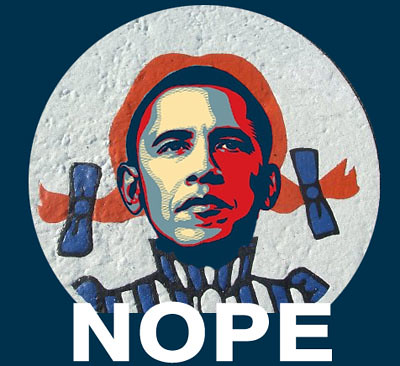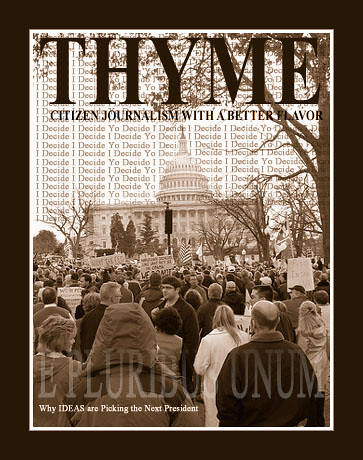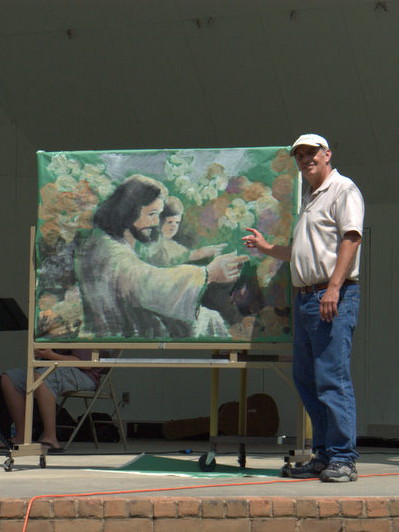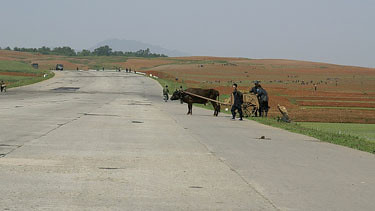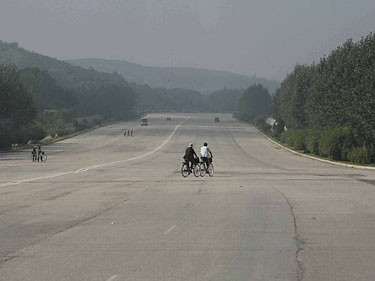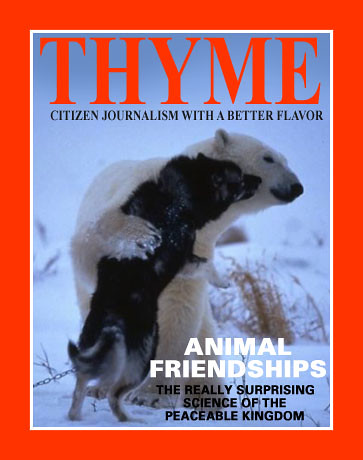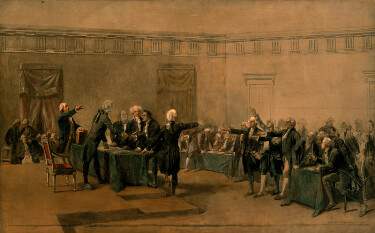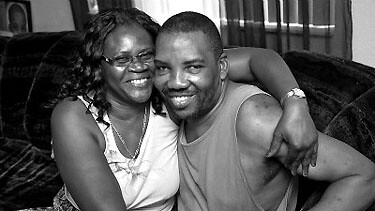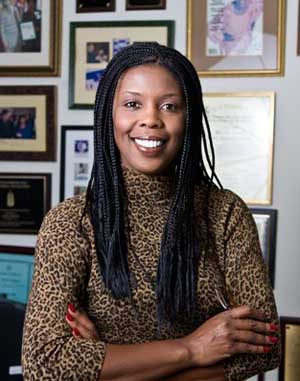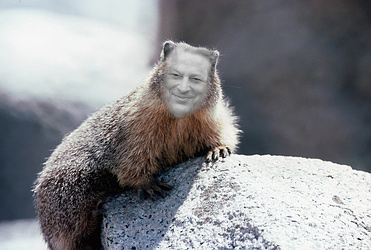Sign Painter Who Visualized Peaceable KingdomA Milestone Monday Feature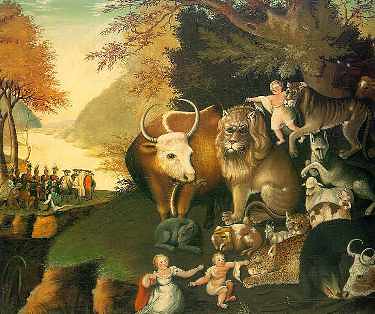 Edward Hicks' 1834 painting of the 'Peaceable Kingdom.'By John Braostoski
Edward Hicks' 1834 painting of the 'Peaceable Kingdom.'By John Braostoski
Friends Journal
February 2000
Many people would recognize the work of
Edward Hicks (1780-1849) in his
Peaceable Kingdom paintings. But it would be a rare person who would know much more about his life and beliefs, which were totally connected with them. Some think of him as a colonial folk artist, untrained and self-taught, simple, sweet, or naive. That view is partially true, but also misleading. Although Hicks was self-taught, he developed sophisticated technical ability and had an educated and penetrating intellect.
His career started as a decorator of carriages and maker of signs. Some of the signs were patriotic, such as views of Washington crossing the Delaware with the moon penetrating storm clouds, like the cosmic eye of G-d, observing and approving of the events. Another was a wooden placard adorned with the face of
Benjamin Franklin. The most curious sign to us might be the one of a joyful jumble of hats for a hatter named Jacob Christ, who surprisingly came from Nazareth, albeit Pennsylvania.
At first his fellow Quakers looked a bit askance at his profession, and because of this, at one time he gave It up to be a farmer. He was unsuccessful at farming, however, and returned to his brushes. It was honest work, so fellow members of his meeting eventually forgave him, especially since he was becoming a strong preacher, traveling among many meetings. He did agree with them about certain vanities in art and refused to paint portraits, which were too ego-centered.
He worked at the time when both the United States and modern American Quakerism were young. His spiritual beliefs came from Barclay and 18th-century quietism, which espoused simplicity, self-discipline, and contact with the Inner Light. FIias Hicks, his second cousin, was a central figure in a religious storm. Edward Hicks was a spokesman, in word and in image, for those who became known as the Hicksites. It broke his heart to see Quakers becoming worldly, with excessive material goods and inflated pride, and leaning towards the creation of a spiritual elite. He felt this corrosion also in the authoritarian control of elders, as mere men, and not as followers of the Inner Spirit of Christ. He had a genuine feeling for the Scriptures, along with hope for a continuing sense of insight open to all. Some of the divisions between urban and rural Quakers have been laid at the feet of visiting Quakers from England, justly or unjustly. In his travels, Hicks spoke much of this.
He also spoke of something else: his own education included ancient concepts of animal symbolism with its references to aspects of human personality. These symbols came into his paintings. The lion was quick-tempered and willful. The wolf was full of melancholy and reserved. The bear was sluggish and greedy. The leopard, buoyant. In his paintings, these were both animal qualities with potential violence as well as the aforementioned rage, egoism, greed, etc. personified.
His
"signature" subject of the peaceable kingdom slowly evolved. His symbols of the animals were joined to a quotation of Isaiah's prophecy in the Bible (Isa. 11:6):
"The wolf shall also dwell with the lamb, and the leopard shall lie down with the kid; and the calf and the young lion and the fatling together; and a little child shall lead them."
Isaiah's words were lettered on the borders, or false frames, around the paintings of the Peaceable Kingdom. Often he paraphrased Isaiah but always centrally included the child. At first he painted a very simple image, with a mixture of wild and domestic animals together. Later he introduced a dividing embankment, which developed into a ravine. On the left side, smaller figures indicated the founders of American Quakerism, William Penn being the most noticeable, concluding a treaty with the Indians. Beyond them was a brilliant sky and sometimes an arriving ship. On the right, the child was surrounded by the well-known duster of unlikely animal companions. The bull and lion were the most pronounced. The lion was offered hay to eat. These were powerful and intense images.
The Peaceable Kingdom paintings portray a delicate balance of difficult and unresolved issues. The lion-ego poses the greatest threat. The wild animals are seemingly domesticated and brought into line with loving kindness. However, their expression of pop-eyed puzzlement is not lost on any viewer. For the moment, they are behaving themselves, eating bovine food and not the little lambs. Hicks's paintings over the years show an increasingly subtle rendering of these animals and children clustered together. His concern is revealed through a tree that appears as if struck by lightning, splitting it. These are not mere decorations added for the naturalistic setting. The divided tree remains a major element in his paintings. As with the animal symbolism, other figures could represent concepts like
"justice" or
"purity." Originally a sign painter, Hicks continued to make
"signs," except that now we have to call them symbols.
The little child had appeared in earlier paintings representing liberty and freedom from autocratic oppression. Politically, that meant kings and princes for' Hicks. But spiritual freedom also has to be obtained. There is a struggle against a foe, not British Quakers or material riches, but the weakness and characteristics of a willful self. The true foe was a self-willed, egotistical, greedy, lustful, or slanderously poisonous self Hicks rejected the authority of the self-aggrandized. He sought the authority of a purer self, washed by the Inner Light, which could reveal religious understandings, even if possibly at odds with established views.
This search was not his alone, and there was resistance to it. A face-off came, with dire results culminating in a division amongst Quakers. For Friends there were many words, not necessarily all polite. Hicks laid the blame upon the inherent human propensities that when uncontrolled turn wild. He felt that a peaceable kingdom was possible, that the child would lead them, that the lamb would lie down with the wolf, etc. Across the ravine was seen an example of William Penn demonstrating how it could be done. There might be other groups of Quakers, with Elias Hicks among them, representing what the artist felt were the better aspects of humankind, wrapped in long ribbons, with messages such as
"Mind the Inner Light." Deeper in the paintings, in colorful satu- rations of light, might be seen a hilltop with a figure and twelve followers, indicating something even loftier, but with no written labels.
With the passage of time, the Peaceable Kingdom paintings became more skillful in technique but saturated with both hope and dashed hopes. The figures became more dispersed. The child plays a lesser role, the animals begin to snarl and raise their claws to strike, divisions become more blatant, the tree more shattered. Hicks became extremely worried about a Quaker reconciliation. The animals become visibly older: white whiskers and sad, sunken eyes. The docility is from fatigue rather than from a peaceful blessing. But this is a fatigue of pride, ego, lust, and greed--perhaps not so bad. All those symbols recede. The sense of light in the gorgeously rendered creatures, trees, and air becomes the subject. How is that? Hicks believed in the Inner Light and its power; he felt it, therefore he saw it. Most importantly, he saw it in others, including the lion and the bear. The world was all light to him, that special Light. He depicted it again in his last painting of David Leedom's farm, where half the painting is luminous sky. The immaculately rendered bulls, sheep, pigs, fences, barns, and people (living or deceased) are saturated in it. No, they are giving it off, being fall of that spirituality, in abundance. It is as if the world is made of diamonds. No, it is made of one diamond.
Edward Hicks allows us to see the Light coming out of all living beings and the world, speaking to that which shines within every one of us.



